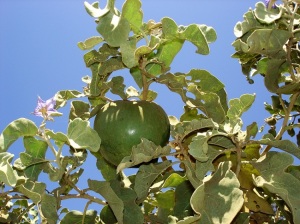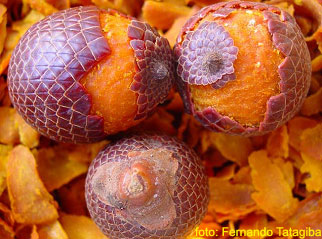
By Everton de Paula
For many it is poison! They say that this fruit was and remains responsible for killing cattle, mainly in the Cerrado. Due to this legendary bad information, landlords have sacrificed the lobeira tree, causing their extinction within a short period, if nothing is done for the benefit of its preservation. Also called Apple of the Cerrado – due to smell like Apple – also known as: jurubebão, field eggplant, etc… See the explanation of the fact of it being a killer: due to the fruit flavor, the cattle jumps fence, crossing streams, ditches and backyards in search of this fruit. He eats up the stone, or better, the lid, which causes his death (photo). This lid hosts the mouth of its stomach, closing it. Nothing else comes in.The cattle ends up dying.
Then, the science from the past, who was away from the field, and the people, without identifying the cause mortis, gave the fateful cause: poison! If this were not inevitable, it could well be called fruit of ox or cow, fruit as the lobo lent its name to it.
Since I was a child I heard scoldings when we played to make it a ball: “look, this is poison, this ‘ little powder ‘ can also loose blind.” Poor Thing! Wronged, it made bitter for long and long years of bitterness! In fact, it somewhat bitter a little when it’s green, nothing unbearable. But the bitter I am referring to is the injustice. Farmers were and sometimes still have horror of this plant. Barely know them today scientists declared it as a medicinal fruit. According to a text by Paulo Capobianco, this fruit is very promising, this century, mainly in the areas of antibiotics, anti-inflammatory drugs and contraceptives. Researching are being developed in the laboratory of Research and Teaching in organic synthesis, University of Brasilia, where they have discovered rich evidence of steroid production, raw material of various medicines, that lobeira offers.
Accordingly, the explanations of this plant it is from the Solanaceae family, as well as the tomato, the Scarlet eggplant, Solanum paniculatum. He discovered also, according to him, the presence of solasodina on lobeira, basic element for the production of steroids. With this discovery, the fruit of the Wolf may be a great ally to the reduction of many medications. See, according to the explanation of Capobianco: “approximately 20 ml medicines for sale in Brazil are produced from only 300 active principles, being 10 steroids that are among the most expensive inputs of the pharmaceutical industry.
From villain it turned into “Excellence” of the Cerrado: homeopathic pharmacies sell their powder, starch polvilho in capsules for slimming, slow down the diabetes, they speak up in relieving stomach pain, such as gastritis. Its flower (pictured) is used to reduce fever, tea making syrup to strengthen the lungs, is widely used in the floral …
Now the fruit of wolf reigns in the fields of the Brazilian cerrado, although there is still resistance and ignorance. The wisest are starting to make the party.
My mother cut pieces, gave the cattle, without its lid, it is logical! Grated for the hens, mixing in sharps, and one which rotted on the ground raised some little bugs, like ladybugs, that the hens and some birds entertained. The rabbit loves its pulp. When I spent some time with the Indians (see more in BRAZILIAN CULTURE) they ate it “divez” passed to mature as we eat an Apple, it was fried in oil. Well, after this coexistence with the fruit of the Wolf, I also have my experiences to tell. I have a small plantation on the ground of the Pousada das Cores, for my own use: make sweets (learned from my mother), invented candy, bran for cakes, smoothies, cakes, etc, put flour enriched with egg shell, cassava leaves, chayotesweet potato, …
Curiosity: according to a legend, anyone who wants to know the first letter of the name of his/her future love, just cut in half and glance will see the first letter of the applicant. I told this story to a former nun and when she did it she saw the name of your childhood boyfriend before her convent. after a few years they were married. True! … They say that every legend has a kernel of truth.




